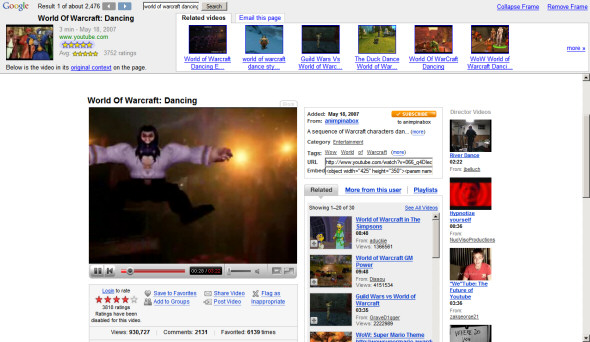So, happy Birthday Google, it’s probably fair to say you’ve achieved more than most in your first 20 years. Google’s birth certificate (i.e. its first website) is dated September 27, 1998. Before then, if you wanted to find anything online, you had to run the gauntlet of crappy search engines, such as dealing with that snooty butler over at Ask Jeeves.
I can still remember the day I first discovered Google. I was sat in an IT lesson at high school and my teacher told the class about a great new search engine called ‘Googol’ (her words), that used a new way to rank results based on quality. This may have been a formative moment in my life, seeing as I’m now working in digital marketing and SEO, so kudos to the foresight of my memory for filing it away.
The genius of Google though, has been to rapidly expand beyond just search. While search (and specifically the income it makes from Google Ads in its search results) is still by far the main breadwinner for the parent company Alphabet, its products and services have crept ever more steadily into so many other areas of our lives.
Not all of Google’s ideas, however, have been a roaring success, even with the backing of near unlimited funds. Here I take a look at some of the company’s more notable failures and the lessons they can teach us when it comes to entrepreneurship.
Google Glass

Image courtesy of Tim Reckmann. CC BY-SA 3.0
Surely the elephant in the Google boardroom for a while, Google Glass was one of their highest profile flops. Back in 2012, it was near impossible not to read countless articles on every tech blog about what everyone thought would be the next big thing. But, unfortunately for Google, it proved to be anything but.
Google launched Glass in 2013 on a very limited release, but almost as soon as the first early adopters were seen wandering around San Fran wearing the things, the backlash began. Lawmakers in the US, EU and elsewhere began responding to privacy and safety concerns by banning their use in certain situations, such as when driving. While the view from the general public was one of unease with the thought of people walking around with a camera strapped to their heads.
Part of the problem with this was the hype-or more precisely, managing the hype effectively. Google quickly lost the narrative when concerns around privacy started to get louder and louder. They also released a product that the market just wasn’t ready for. What’s more, the product’s design left a lot to be desired, which flew in the face of the design led thinking that Google usually deployed. However, it looks like Google Glass may be making a comeback now the market has started to catch up with the ambition.
Google Video

Image courtesy of Alex Chitu
Remember this? It was Google’s answer to Youtube, way back when mass broadband adoption made video streaming a reality for the masses. There was nothing particularly bad about the service, but by the time of its launch in 2005, Youtube was already firmly established as the market leader. And being a user generated content platform, not many users means not much content, which in turn means not many users; a classic vicious circle.
We all know how this story ended, Google simply bought up the competition and maintained the huge brand value of Youtube by keeping it as a standalone platform. What this story tells us about is the danger of launching a product or service when the market is already dominated by one or more players. This is even more the case in a market that requires a huge amount of active users to make the business model work.
Google Wave
Perhaps one of the most perplexing products ever rolled out by Google, Wave was a bit of an oddity for a company built upon the simplicity of its user experience. First released in 2009, Wave allowed users to simultaneously work on the same document or project, a bit like the multiple-user functionality of Drive. But it wasn’t a Doc or Sheet file, instead it was more of a blank space where users could add images, links, videos and other type of content. Oh, and they could also chat to one another. Confused? Well you’re not alone. The unfathomable user interface (UI) killed user uptake and Google quietly discounted the service in 2012.
The lesson with Wave is pretty clear: never lose sight of your UI. If it’s not intuitive, then users are going to shun it. This is a golden rule when it comes to software aimed at the general user. While professional grade software requires training and development, the general user is not going to commit their valuable time learning how to use a complicated UI. This is especially true when they have access to dozens of similar tools that are much easier to use.
Google Plus
Creating a new social media network from scratch, after Facebook and Twitter had firmly established themselves? What could possibly go wrong? Well, not getting any users, for one thing. But before I go on, just to clarify, I’m talking here specifically about the social media network element of Google Plus, not Google’s global login. The platform has some nice features, following Google’s general UI philosophy of neatly filled and easily searchable content. However, regardless of how useful some of the features were, it just couldn’t compete with Facebook.
We can learn a few things from Google Plus’ failure to break the social media market. First off, it was essentially a social network designed by committee, in Google’s corporate boardrooms. All the other major players started from nothing, being built from the ground up and based entirely on user requirements. And the other lesson is one of hubris; a company with near unlimited resources can’t always break into every market that it wants to. This is especially the case when that market has already been consolidated by a few all powerful companies.
Beyond the learnings we can take from each failed project, the bigger lesson here is not to be afraid of failure. Or as those inspirational t-shirts proclaim: “Don’t be afraid to fail, be afraid not to try”.
Or as my own, far more eloquent version goes (which greats my co-workers each morning when they load up Slack): “Don’t be afraid to fail. Be afraid not to fail, due to not having been afraid not to have tried”.







